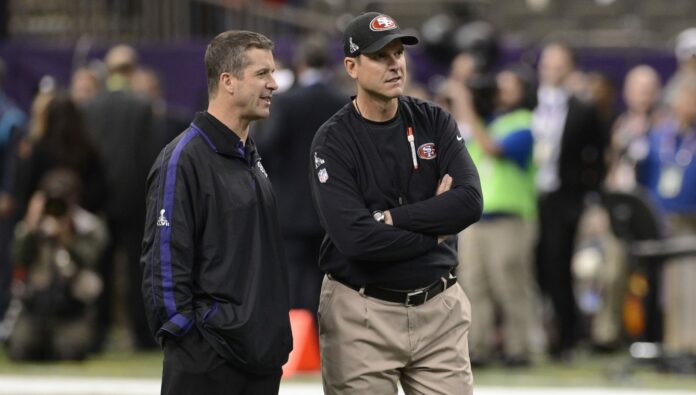Baltimore Ravens coach John Harbaugh didn’t have his things go when his team decided to go for two at the end of a 20-19 loss to the Steelers Dec. 5 at Heinz Field in Pittsburgh. Lamar Jackson’s pass to tight end Mark Andrews bounced off his hands and the Ravens lost as -225 favorites according to Vegas NFL odds.
Analytics today favor coaches going for two because the math is in favor of taking the risk. Attempting a two-point conversion to avoid overtime is something that coaches have grappled with for a long time. Harbaugh’s decision to not send his future Hall of Fame kicker Justin Tucker out to attempt a game-tying extra point will be debated for this season. But that decision is nothing compared to what Nebraska coach Tom Osborne did in the 1984 Orange Bowl.
Contents
The Two-Point Conversion’s History
The NFL was much slower to adopt the two-point conversion than the rest of the football world. College football added the rule in 1958 and the Canadian football League brought it into the fold in 1975. Even the AFL before it merged with the NFL in 1970 utilized the rule.
The NFL, however, did not add it until 1994. The two-point conversion was originally created to cut down on the number of tie games and help teams that are trailing in games catch up.
Osborne Thought He Had the Team
Tom Osborne was Nebraska’s football coach from 1973 to 1997 and compiled a 83.6 winning percentage and a record of 255-49-3. Despite Osborne’s nearly universal domination of the Big East, for a long time Osborne was known for not being able to win a national championship.
In 1983, everyone agreed Osborne had the team to do it. During the regular season, Nebraska opened the season No. 1 and bludgeoned most of its opponents. The Cornhuskers scored 50 or more points in a game seven times.
The only team that played Nebraska close was Oklahoma State, which dropped a 14-10 decision. By the time the Cornhuskers reached the Orange Bowl their winning streak stood at 22 games.
Not Quite “The ‘U’” Yet
Nebraska would have to play No. 5 Miami in the 1984 Orange Bowl to win the title. The Hurricanes had yet to become the powerhouse they were in the late 1980s and early 1990s. Many expected Nebraska would romp over the Hurricanes despite the game being played in Miami.
The Hurricanes caught everyone off guard, jumping out to a 17-0 lead in the first quarter thanks to two touchdown passes from Bernie Kosar.
Nebraska entered the fourth quarter trailing 31-17 before its offense woke up. Jeff Smith scored two touchdown runs, including a 24-yard run with 48 seconds remaining to cut the score to 31-30.
Since college football didn’t add overtime until 1996, games could still end in a tie. Had Nebraska decided to kick the extra point, the Cornhuskers likely would have been voted the top football team in the country.
Osborne decided to go for two points and the win. Nebraska quarterback Turner Gil rolled out and attempted a pass to win the game, but it fell short and Miami escaped with its first national title in its history.
11-Year Wait
Osborne would have to wait until 1994 to win his first championship. Osborne closed his career in grand style, winning outright championships in 1994 and 1995. The Cornhuskers would also split a national championship with Michigan in 1997, which was Osborne’s final season as coach.
Asked 30 years after the game, Osborne would simply tell people you play to win.












![Index of Money Heist [Season 1, 2, 3 & 4 – All Episodes, Cast and Plot] Index of Money Heist](https://www.asiamediajournal.com/wp-content/uploads/2021/05/Index-of-Money-Heist-3-100x70.jpg)